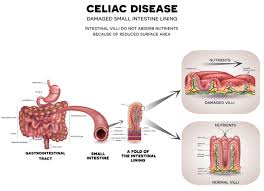
How to diagnose Celiac disease

Celiac disease is a condition that involves your bodys reaction to the protein gluten, which is found in the common grains wheat, barley, and rye. Because the tests for celiac disease are looking specifically for signs of this small intestine damage, you must be eating gluten for the tests to be accurate.
If you are not eating gluten-containing foods or not eating enough of them it is possible for the testing to come up negative, even if you actually do have celiac disease. Therefore, you should continue eating a normal diet, with gluten-containing foods several times a day, until all your testing is completed.
First Step in Celiac Disease diagnosis: Blood Tests
The celiac disease blood tests look for antibodies that show your immune systems response to the gluten in your diet--that is why you need to be eating gluten when you are tested for celiac disease.
Next Step: Endoscopy and Intestinal Biopsy
If your celiac disease blood tests come back positive or if they are negative, but you and your physician agree on the need for further testing anyway your next step is a procedure known as an endoscopy. This usually is performed by a gastroenterologist, one of the many types of doctors who treat celiac disease.
Process in Endoscopy
In an endoscopy, an instrument with a tiny camera attached is threaded down your throat so your physician can look directly at the lining of your small intestine to see if villous atrophy is present. In some cases (but not all), the damage from celiac disease can be seen immediately during this procedure.
Process in Intestinal Biopsy
However, to confirm the diagnosis, the surgeon also will use the instrument to take tiny samples of your intestine. Because damage from celiac disease can be patchy, the surgeon should take at least four to six samples.
Celiac Disease Diagnossis Means Gluten-Free Diet
Positive test results for celiac disease on your endoscopy and biopsy means you definitely have the condition, and must follow the gluten-free diet for life. Negative testing, meanwhile, does not mean you definitely do not have a problem with gluten. You can test negative on celiac blood tests and biopsy and still suffer from problems related to gluten ingestion.


